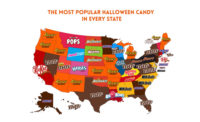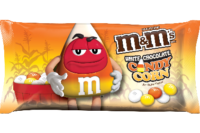Despite continued concerns about sugar and obesity, it looks like Americans will still be indulging in some treats this Halloween.
A new National Confectioners Association (NCA) national survey reveals that more than three-quarters of Americans will hand out candy to trick-or-treaters this year and many others will participate in community-sponsored Halloween events, display a seasonal candy bowl, or attend a Halloween party.
In fact, the NCA projects that retail sales of Halloween candy in 2015 will be $2.6 billion.
But what kind of candy, specifically, will most people be hoping to get in their Trick or Treat bags? Well, the top four candies, along with what percentage of people who said it was their favorite, include:
1. Chocolate (70 percent)
2. Candy corn(13 percent)
3. Chewy candy (6 percent)
4. Gummy candy (5 percent)
Despite chocolate's popularity though, most Americans (63 percent) say they stock their trick-or-treat candy bowls with a mix of chocolate and non-chocolate, so that they can be sure to have something everyone will like.
And when it comes to selecting candies in shapes like spiders, eyeballs and brains to inspire seasonal celebrations, parents are 24 percent more likely than non-parents to pick creepy candy over other Halloween themes.
But just because trick-or-treaters are planning to indulge, that doesn’t mean they plan to wake up Nov. 1 with a stomach ache. As the holiday approaches, nearly 80 percent of parents report that they have a plan in place to help their children make smart decisions when it comes to the enjoyment of treats.
"People understand that candy is a treat, and this year's survey tells us that they are celebrating Halloween in more ways than ever and practicing moderation," says Alison Bodor, executive v.p. of the NCA. "Parents, including me, are embracing Halloween celebrations and traditions, but we're also using the holiday as an opportunity to teach our children how to enjoy candy as a fun part of a balanced lifestyle."
According to NCA's seasonal survey, more than 90 percent of parents discuss or plan to discuss balance and moderation with their children regarding their candy consumption, and while most report having these conversations year-round, many use the holiday as a starting point.
Those who stay home to hand out candy also recognize the importance of balance and moderation. More than 60 percent of respondents prefer to hand candy to trick-or-treaters, rather than having the ghosts and goblins help themselves, and nearly 60 percent of those surveyed believe that up to two pieces is just the right amount per household.
Halloween Is Meant For Sharing
Halloween continues to be the top candy-giving holiday with 86 percent of people gifting or sharing chocolate or other candy.
Seven in 10 people believe that holidays like Halloween are meant for enjoying candy, and that it is important to do so in moderation.
Parents also support the notion that sharing is a critical piece of the Halloween celebration — a full 80 percent report that they enjoy some of their children's Halloween bounty by either sneaking it when the kids aren't looking (23 percent) or by instituting a house rule that it must be shared (57 percent).
NCA's survey revealed that 81 percent of Americans support the notion that candy is a treat and 75 percent agree that it is okay to enjoy seasonal chocolate or candy.
And, almost 20 percent of consumers say they are more likely to buy seasonal candy in smaller portion sizes than they were five years ago.
Keeping An Eye On The Candy Stash
Nearly four in five parents (79 percent) encourage moderation by keeping tabs on their children's candy consumption following Halloween, but they take different approaches.
Some limit their children to a certain number of pieces per day (35 percent), a total number of pieces overall (14 percent), or a general amount of calories (9 percent) and then take the rest away.
Twenty-one percent opt to take responsibility for the candy and dole it out as appropriate.
NCA supported research at Pennsylvania State University to help parents learn practices that promote balance and moderation with treats in their homes. As part of that research, a scientific literature review published recently in the Journal of Pediatric Obesity concluded that simply restricting or forbidding children from having snack foods or other treats, like candy, is not an effective approach to helping them learn how to consume these foods in moderation.
So maybe just keep it to a couple pieces a day, which has the added bonus of making that Halloween candy last well into the new year.





